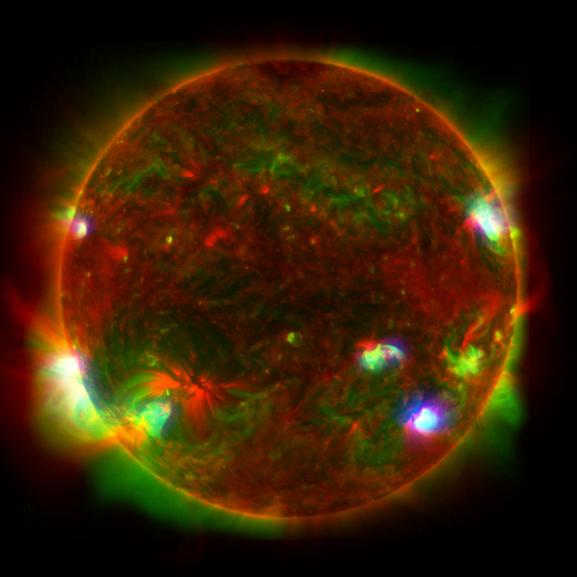You’ve probably never seen our Sun look like this before. This bizarre image of old Sol is made from data produced by three different space telescopes, each observing the Sun at a different wavelength.
The spacecraft that teamed up for this image are NASA’s Nuclear Spectroscopic Telescope Array (NuSTAR) which sees in high-energy X-rays; the X-ray Telescope on Japan’s Hinode mission which observes in lower-energy X-rays; and NASA’s Solar Dynamics Observatory, which can observe the Sun in multiple wavelengths (13!) but this particular view is in the ultraviolet.
The composite image speaks to the longevity of these three missions. Hinode launched in 2006; it was supposed to be just a three-year mission but it is still operating. SDO launched in 2010 and is still going strong, capturing as much as 1.4 terabytes of data every day! NuSTAR launched in 2012 and its primary mission is not looking at the Sun, but instead focusing on light in the high energy X-rays in our Universe. It has been taking a census of collapsed stars and black holes of different sizes by surveying regions surrounding the center of own Milky Way Galaxy and performing deep observations of the extragalactic sky.
The blue portions come NuSTAR, while the green comes from Hinode, while red is courtesy of SDO. See the individual images below.

NASA said that NuSTAR’s relatively small field of view means it can’t see the entire Sun from its position in Earth orbit, so the NuSTAR image is a composite of 25 images, which were taken by the observatory in June 2022. The high-energy X-rays that NuSTAR can see only appear a few locations, where the hottest material is present in the Sun’s atmosphere.

In contrast, Hinode’s X-Ray Telescope (XRT) and SDO’s Atmospheric Imaging Assembly (AIA) can both detect wavelengths emitted across the entire face of the Sun. The hotspots observed by NuSTAR might be caused by collections of nanoflares, or small outbursts of heat, light, and particles from the Sun’s surface that subsequently heat the atmosphere. Individual nanoflares are too faint to directly observe amid the Sun’s blazing light.



That’s incredible, I love seeing (“seeing” lol) images of all kinds of different wavelengths put together!!! It’s just so fascinating to me. Thank you!